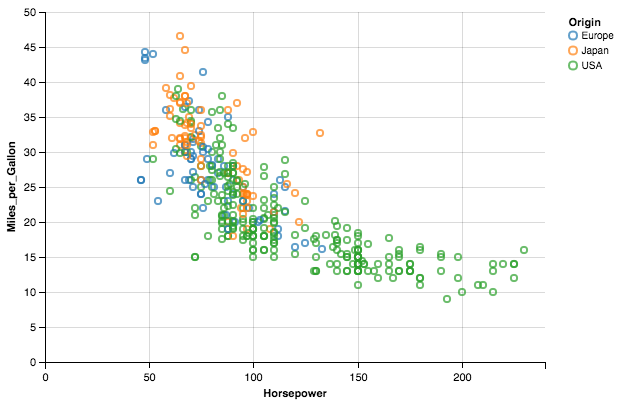Altair
A High-level declarative visualization library for Python.
Altair provides a Python API for building statistical visualizations in a declarative manner. By statistical visualization we mean:
- The data source is a data frame that consists of column of different data types (quantitative, ordinal, nominal and date/time).
- The data frame is in a tidy format where the rows correspond to samples and the colunms correspond the observed variables.
- The visual encoding (position, color, size, shape, facetting, etc.) of the different columns is intimately related to the groupby operation of Pandas and SQL.
The Altair API contains no actual visualization rendering code, but instead emits JSON data structures following the Vega-Lite specification. For convenience, Altair can optionally use ipyvega to seamlessly display client-side renderings in the Jupyter notebook.
Altair is developed by Brian Granger and Jake Vanderplas in close collaboration with the Interactive Data Lab at the University of Washington.
Features
- Carefully-designed, declarative Python API based on traitlets.
- Auto-generated internal Python API that guarantees visualizations are type-checked and in full conformance with the Vega-Lite specification.
- Auto-generate Altair Python code from a Vega-Lite JSON spec.
- Display visualizations in the live Jupyter Notebook, on GitHub and nbviewer.
- Export visualizations to PNG images, stand-alone HTML pages and the online Vega-Lite Editor.
- Serialize visualizations as JSON files.
- Explore Altair with 40 example datasets.
Examples
Here is an example of how Altair can be used to quickly visualize a dataset. The figure is displayed using the native Vega-Lite renderer:
from altair import Chart, load_dataset
# data is loaded as a pandas DataFrame
cars = load_dataset('cars')
Chart(cars).mark_point().encode(
x='Horsepower',
y='Miles_per_Gallon',
color='Origin',
)For more information and examples of Altair's API, see the Altair Documentation.
Philosophy
There are currently many excellent plotting libraries in Python. The main ones are:
Each of these libraries does a certain set of things really well. However, such a proliferation of options creates great difficulty for users as they have to wade through all of these APIs to find which of them is the best for the task at hand. Furthermore, because none of these libraries are optimized for high-level statistical visualization, users have to assemble their own using a mish-mash of APIs. For individuals just learning data science, this forces them to focus on learning APIs rather than exploring their data.
Another challenge is that all of the current APIs require the user to write code, even for incidental aspects of a visulization. This is unfortunate and unnecessary as the type of visualization (histogram, scatterplot, etc.) can often be inferred with basic information such as the columns of interest and the data types of those columns. For example, if you are interested in a visualization of two numerical columns, a scatterplot is almost certainly a good starting point. If you add a categorical column to that, you probably want to encode that column using colors or facets. In cases where the visualization can't be inferred, simple user interfaces can enable the construction of visualizations without any coding. Tableau and the Interactive Data Lab's Polestar and Voyager are excellent examples of such UIs.
We feel that these challenges can be addressed without creation of yet another visualization library that has a programmatic API and built-in rendering. The approach of Altair is to build visualizations using a layered approach that leverages the full capabilities of existing visualization libraries:
- A constrained and simple Python API (Altair) that is purely declarative and emits JSON that follows the Vega-Lite spec.
- Existing visualization libraries which can render that spec.
This approach enables users to perform exploratory visualizations with a much simpler API initially, pick an appropriate renderer for their usage case, and then leverage the full capabilities of that renderer for more advanced plot customization.
We realize that a declarative API will necessarily be limited compared to the full programatic APIs of Matplotlib, Bokeh, etc. That is a deliberate design choice we feel is needed to simplify the user experience of exploratory visualization.
Installation
Altair requires the following dependencies:
For visualization in the IPython/Jupyter notebook using the Vega-Lite renderer, Altair additionally requires
Assuming you have NumPy, Pandas and the Jupyter Notebook installed, ipyvega and Altair can be installed with the following commands:
pip install altair
jupyter nbextension install --sys-prefix --py vega
Coming soon: streamlined installation with conda.
Development install
If you have cloned the repository, run the following command from the root of the repository:
pip install -e .
If you do not wish to clone the repository, you can install using:
pip install git+https://github.com/ellisonbg/altair
Testing
Altair's test suite uses py.test. To run tests, use
py.test altair
Feedback and Contribution
We welcome any input, feedback, bug reports, and contributions via Altair's GitHub Repository. In particular, we welcome companion efforts from other visualization libraries to render the Vega-Lite specifications output by Altair. We see this portion of the effort as much bigger than Altair itself: the Vega and Vega-Lite specifications are perhaps the best existing candidates for a principled lingua franca of data visualization.
Whence Altair?
Altair is the brightest star in the constellation Aquila, and along with Deneb and Vega forms the northern-hemisphere asterism known as the Summer Triangle.

